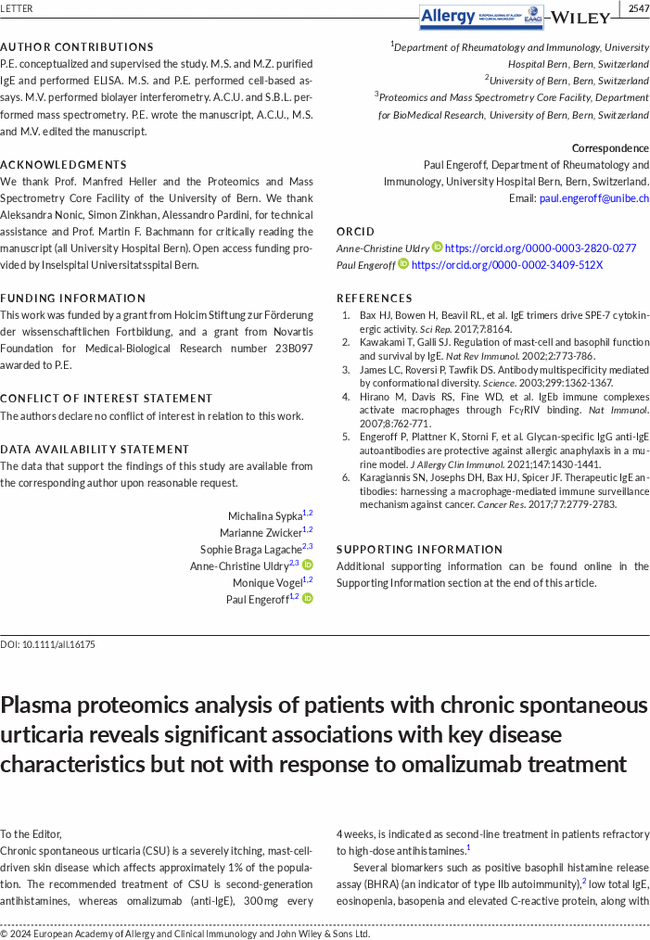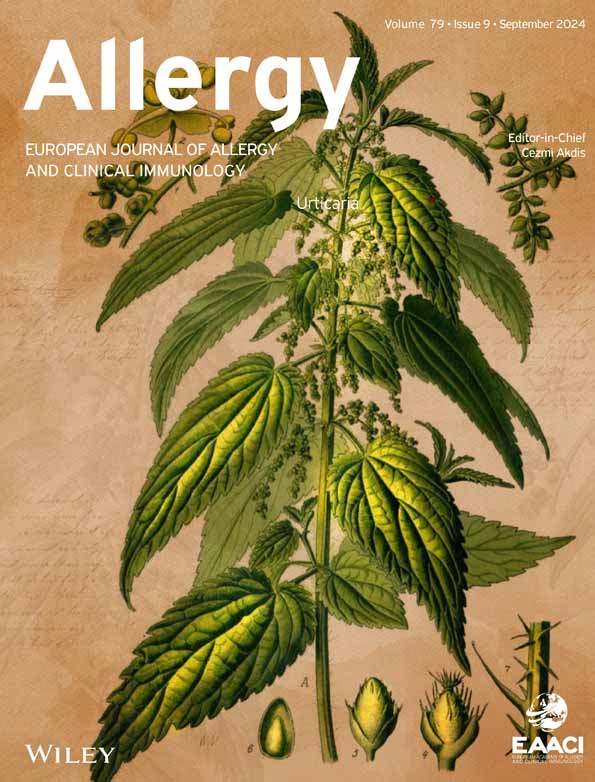Plasma proteomics analysis of patients with chronic spontaneous urticaria reveals significant associations with key disease characteristics but not with response to omalizumab treatment
Corresponding Author
Misbah Noshela Ghazanfar
Department of Dermato-Venereology & Wound Healing Centre, Urticaria Center of Reference and Excellence (UCARE), Bispebjerg Hospital, Copenhagen, Denmark
Correspondence
Misbah Noshela Ghazanfar, Department of Dermato-Venereology & Wound Healing Centre, Bispebjerg Hospital, Bispebjerg Bakke 23, DK-2400 Copenhagen NV, Denmark.
Email: [email protected]
Search for more papers by this authorValdemaras Petrosius
Department of Biotechnology and Biomedicine, Technical University of Denmark, Kongens Lyngby, Denmark
Search for more papers by this authorJennifer Astrup Sørensen
Department of Dermato-Venereology & Wound Healing Centre, Urticaria Center of Reference and Excellence (UCARE), Bispebjerg Hospital, Copenhagen, Denmark
Search for more papers by this authorDitte Georgina Zhang
Department of Dermato-Venereology & Wound Healing Centre, Urticaria Center of Reference and Excellence (UCARE), Bispebjerg Hospital, Copenhagen, Denmark
Search for more papers by this authorZarqa Ali
Department of Dermato-Venereology & Wound Healing Centre, Urticaria Center of Reference and Excellence (UCARE), Bispebjerg Hospital, Copenhagen, Denmark
Search for more papers by this authorMarcus Maurer
Urticaria Center of Reference and Excellence (UCARE), Institute of Allergology, Charité – Universitätsmedizin Berlin, Corporate Member of Freie Universität Berlin and Humboldt-Universität zu Berlin, Berlin, Germany
Fraunhofer Institute for Translational Medicine and Pharmacology ITMP, Immunology and Allergology, Berlin, Germany
Search for more papers by this authorEmek Kocatürk
Urticaria Center of Reference and Excellence (UCARE), Institute of Allergology, Charité – Universitätsmedizin Berlin, Corporate Member of Freie Universität Berlin and Humboldt-Universität zu Berlin, Berlin, Germany
Fraunhofer Institute for Translational Medicine and Pharmacology ITMP, Immunology and Allergology, Berlin, Germany
Department of Dermatology, Koç University School of Medicine, Istanbul, Turkey
Search for more papers by this authorValdemar Wendelboe Nielsen
Department of Dermato-Venereology & Wound Healing Centre, Urticaria Center of Reference and Excellence (UCARE), Bispebjerg Hospital, Copenhagen, Denmark
Search for more papers by this authorSimonas Savickas
Department of Biotechnology and Biomedicine, Technical University of Denmark, Kongens Lyngby, Denmark
Search for more papers by this authorUlrich auf dem Keller
Department of Biotechnology and Biomedicine, Technical University of Denmark, Kongens Lyngby, Denmark
Search for more papers by this authorErwin M. Schoof
Department of Biotechnology and Biomedicine, Technical University of Denmark, Kongens Lyngby, Denmark
Search for more papers by this authorSimon Francis Thomsen
Department of Dermato-Venereology & Wound Healing Centre, Urticaria Center of Reference and Excellence (UCARE), Bispebjerg Hospital, Copenhagen, Denmark
Department of Biomedical Sciences, University of Copenhagen, Copenhagen, Denmark
Search for more papers by this authorCorresponding Author
Misbah Noshela Ghazanfar
Department of Dermato-Venereology & Wound Healing Centre, Urticaria Center of Reference and Excellence (UCARE), Bispebjerg Hospital, Copenhagen, Denmark
Correspondence
Misbah Noshela Ghazanfar, Department of Dermato-Venereology & Wound Healing Centre, Bispebjerg Hospital, Bispebjerg Bakke 23, DK-2400 Copenhagen NV, Denmark.
Email: [email protected]
Search for more papers by this authorValdemaras Petrosius
Department of Biotechnology and Biomedicine, Technical University of Denmark, Kongens Lyngby, Denmark
Search for more papers by this authorJennifer Astrup Sørensen
Department of Dermato-Venereology & Wound Healing Centre, Urticaria Center of Reference and Excellence (UCARE), Bispebjerg Hospital, Copenhagen, Denmark
Search for more papers by this authorDitte Georgina Zhang
Department of Dermato-Venereology & Wound Healing Centre, Urticaria Center of Reference and Excellence (UCARE), Bispebjerg Hospital, Copenhagen, Denmark
Search for more papers by this authorZarqa Ali
Department of Dermato-Venereology & Wound Healing Centre, Urticaria Center of Reference and Excellence (UCARE), Bispebjerg Hospital, Copenhagen, Denmark
Search for more papers by this authorMarcus Maurer
Urticaria Center of Reference and Excellence (UCARE), Institute of Allergology, Charité – Universitätsmedizin Berlin, Corporate Member of Freie Universität Berlin and Humboldt-Universität zu Berlin, Berlin, Germany
Fraunhofer Institute for Translational Medicine and Pharmacology ITMP, Immunology and Allergology, Berlin, Germany
Search for more papers by this authorEmek Kocatürk
Urticaria Center of Reference and Excellence (UCARE), Institute of Allergology, Charité – Universitätsmedizin Berlin, Corporate Member of Freie Universität Berlin and Humboldt-Universität zu Berlin, Berlin, Germany
Fraunhofer Institute for Translational Medicine and Pharmacology ITMP, Immunology and Allergology, Berlin, Germany
Department of Dermatology, Koç University School of Medicine, Istanbul, Turkey
Search for more papers by this authorValdemar Wendelboe Nielsen
Department of Dermato-Venereology & Wound Healing Centre, Urticaria Center of Reference and Excellence (UCARE), Bispebjerg Hospital, Copenhagen, Denmark
Search for more papers by this authorSimonas Savickas
Department of Biotechnology and Biomedicine, Technical University of Denmark, Kongens Lyngby, Denmark
Search for more papers by this authorUlrich auf dem Keller
Department of Biotechnology and Biomedicine, Technical University of Denmark, Kongens Lyngby, Denmark
Search for more papers by this authorErwin M. Schoof
Department of Biotechnology and Biomedicine, Technical University of Denmark, Kongens Lyngby, Denmark
Search for more papers by this authorSimon Francis Thomsen
Department of Dermato-Venereology & Wound Healing Centre, Urticaria Center of Reference and Excellence (UCARE), Bispebjerg Hospital, Copenhagen, Denmark
Department of Biomedical Sciences, University of Copenhagen, Copenhagen, Denmark
Search for more papers by this author
Open Research
DATA AVAILABILITY STATEMENT
The data that support the findings of this study are available on request from the corresponding author. The data are not publicly available due to privacy or ethical restrictions.
Supporting Information
| Filename | Description |
|---|---|
| all16175-sup-0001-SupinfoS1.pptxPowerPoint 2007 presentation , 45.9 MB |
Data S1. |
| all16175-sup-0002-SupinfoS2.docxWord 2007 document , 20.8 KB |
Data S2. |
Please note: The publisher is not responsible for the content or functionality of any supporting information supplied by the authors. Any queries (other than missing content) should be directed to the corresponding author for the article.
REFERENCES
- 1Zuberbier T, Abdul Latiff AH, Abuzakouk M, et al. The international EAACI/GA2LEN/EuroGuiDerm/APAAACI guideline for the definition, classification, diagnosis, and management of urticaria. Allergy Eur J Allergy Clin Immunol. 2022; 77(3): 734-766.
- 2Kolkhir P, Muñoz M, Asero R, et al. Autoimmune chronic spontaneous urticaria. J Allergy Clin Immunol. 2022; 149(6): 1819-1831.
- 3Kolkhir P, Church MK, Altrichter S, et al. Eosinopenia, in chronic spontaneous urticaria, is associated with high disease activity, autoimmunity, and poor response to treatment. J Allergy Clin Immunol Pract. 2019; 8(1): 318-325.e5. doi:10.1016/j.jaip.2019.08.025
- 4Maurer M, Metz M, Bindslev-Jensen C, et al. Definition, aims, and implementation of GA2LEN urticaria centers of reference and excellence. Allergy Eur J Allergy Clin Immunol. 2016; 71(8): 1210-1218.
- 5Hu C, Yang J, Qi Z, et al. Heat shock proteins: biological functions, pathological roles, and therapeutic opportunities. MedComm. 2022; 3(3): 1-39.
- 6Kaplan A, Lebwohl M, Giménez-Arnau AM, Hide M, Armstrong AW, Maurer M. Chronic spontaneous urticaria: focus on pathophysiology to unlock treatment advances. Allergy Eur J Allergy Clin Immunol. 2023; 78(2): 389-401.




